埃森哲-EXECOV韩国银行咨询报告
埃森哲(中国)有限公司介绍企业发展分析报告
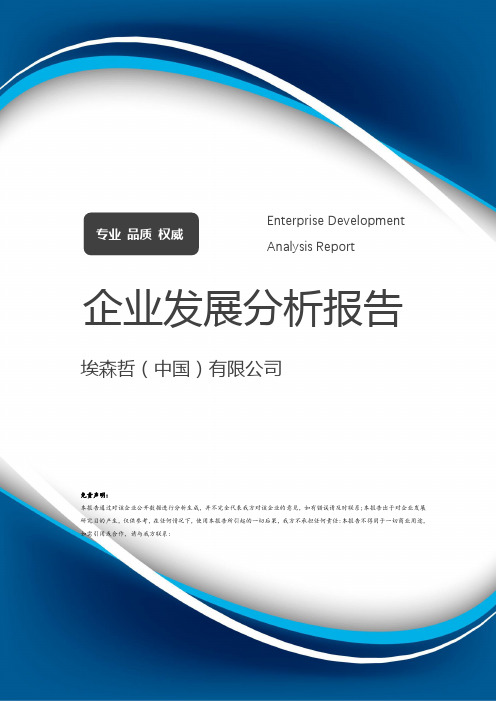
Enterprise Development专业品质权威Analysis Report企业发展分析报告埃森哲(中国)有限公司免责声明:本报告通过对该企业公开数据进行分析生成,并不完全代表我方对该企业的意见,如有错误请及时联系;本报告出于对企业发展研究目的产生,仅供参考,在任何情况下,使用本报告所引起的一切后果,我方不承担任何责任:本报告不得用于一切商业用途,如需引用或合作,请与我方联系:埃森哲(中国)有限公司1企业发展分析结果1.1 企业发展指数得分企业发展指数得分埃森哲(中国)有限公司综合得分说明:企业发展指数根据企业规模、企业创新、企业风险、企业活力四个维度对企业发展情况进行评价。
该企业的综合评价得分需要您得到该公司授权后,我们将协助您分析给出。
1.2 企业画像类别内容行业软件和信息技术服务业-软件开发资质增值税一般纳税人产品服务业管理咨询,广告设计代理,广告制作,广告1.3 发展历程2工商2.1工商信息2.2工商变更2.3股东结构2.4主要人员2.5分支机构2.6对外投资2.7企业年报2.8股权出质2.9动产抵押2.10司法协助2.11清算2.12注销3投融资3.1融资历史3.2投资事件3.3核心团队3.4企业业务4企业信用4.1企业信用4.2行政许可-工商局4.3行政处罚-信用中国4.5税务评级4.6税务处罚4.7经营异常4.8经营异常-工商局4.9采购不良行为4.10产品抽查4.12欠税公告4.13环保处罚4.14被执行人5司法文书5.1法律诉讼(当事人)5.2法律诉讼(相关人)5.3开庭公告5.4被执行人5.5法院公告5.6破产暂无破产数据6企业资质6.1资质许可6.2人员资质6.3产品许可6.4特殊许可7知识产权7.1商标7.2专利7.3软件著作权7.4作品著作权7.5网站备案7.6应用APP7.7微信公众号8招标中标8.1政府招标8.2政府中标8.3央企招标8.4央企中标9标准9.1国家标准9.2行业标准9.3团体标准9.4地方标准10成果奖励10.1国家奖励10.2省部奖励10.3社会奖励10.4科技成果11 土地11.1大块土地出让11.2出让公告11.3土地抵押11.4地块公示11.5大企业购地11.6土地出租11.7土地结果11.8土地转让12基金12.1国家自然基金12.2国家自然基金成果12.3国家社科基金13招聘13.1招聘信息感谢阅读:感谢您耐心地阅读这份企业调查分析报告。
银行咨询研究报告
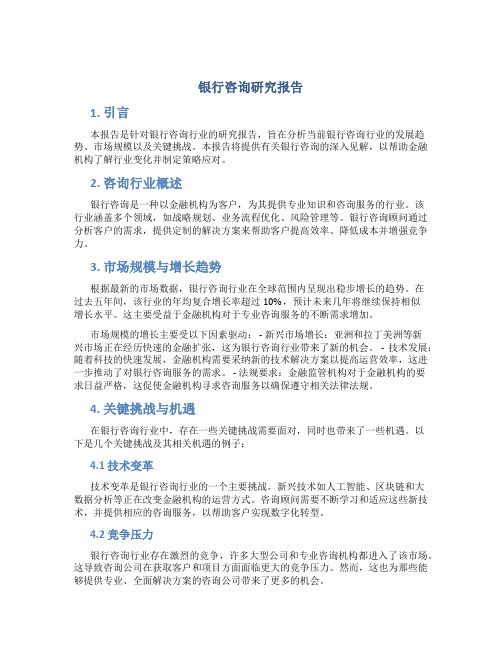
银行咨询研究报告1. 引言本报告是针对银行咨询行业的研究报告,旨在分析当前银行咨询行业的发展趋势、市场规模以及关键挑战。
本报告将提供有关银行咨询的深入见解,以帮助金融机构了解行业变化并制定策略应对。
2. 咨询行业概述银行咨询是一种以金融机构为客户,为其提供专业知识和咨询服务的行业。
该行业涵盖多个领域,如战略规划、业务流程优化、风险管理等。
银行咨询顾问通过分析客户的需求,提供定制的解决方案来帮助客户提高效率、降低成本并增强竞争力。
3. 市场规模与增长趋势根据最新的市场数据,银行咨询行业在全球范围内呈现出稳步增长的趋势。
在过去五年间,该行业的年均复合增长率超过10%,预计未来几年将继续保持相似增长水平。
这主要受益于金融机构对于专业咨询服务的不断需求增加。
市场规模的增长主要受以下因素驱动: - 新兴市场增长:亚洲和拉丁美洲等新兴市场正在经历快速的金融扩张,这为银行咨询行业带来了新的机会。
- 技术发展:随着科技的快速发展,金融机构需要采纳新的技术解决方案以提高运营效率,这进一步推动了对银行咨询服务的需求。
- 法规要求:金融监管机构对于金融机构的要求日益严格,这促使金融机构寻求咨询服务以确保遵守相关法律法规。
4. 关键挑战与机遇在银行咨询行业中,存在一些关键挑战需要面对,同时也带来了一些机遇。
以下是几个关键挑战及其相关机遇的例子:4.1 技术变革技术变革是银行咨询行业的一个主要挑战。
新兴技术如人工智能、区块链和大数据分析等正在改变金融机构的运营方式。
咨询顾问需要不断学习和适应这些新技术,并提供相应的咨询服务,以帮助客户实现数字化转型。
4.2 竞争压力银行咨询行业存在激烈的竞争,许多大型公司和专业咨询机构都进入了该市场。
这导致咨询公司在获取客户和项目方面面临更大的竞争压力。
然而,这也为那些能够提供专业、全面解决方案的咨询公司带来了更多的机会。
4.3 市场需求变化金融机构的需求正在不断变化,他们需要咨询公司提供更加定制化和全面的解决方案。
埃森哲流程项目咨询报告ppt课件
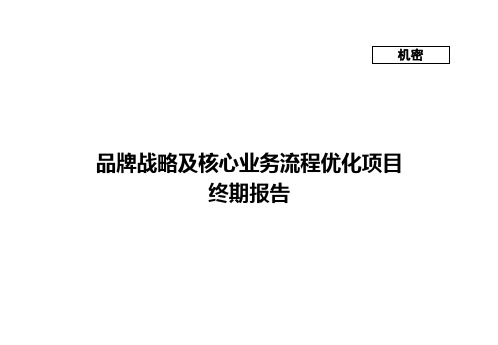
关键成功因素
流程目标
• 明确的公司发展战略和市场策略 • 全面、详细的综合分析 • 统一、科学的计划协调机制 • 规范、严格的设计开发控制 • 严谨的计划制订、评审、评估机制,规范、
严格的计划过程协调控制 • 明确、流程导向的部门职责 • 规范的战略供应商管理 • 良好的内部沟通、协调机制
• 缩短市场反应时间 • 提高运营效率 • 提高产销率 • 减少内部纠纷 • 提高内外部客户满意度 • 建立协同的、双赢的供应商关系 • 建立合作协同的管理团队
机密
品牌战略及核心业务流程优化项目 终期报告
核心业务流程调整方案
品牌战略及核心业务流程优化项目 终期报告
流程优化工作回顾 部分关键流程规范成果
流程优化实施建议
保密文件,版权所有
第1页
品牌战略及核心业务流程优化项目 终期报告
在项目的初期,项目组使用各种调研手段分析和梳理了ZZ 的核心业务流程现状
内部访谈
保密文件,版权所有
第6页
品牌战略及核心业务流程优化项目 终期报告
公司运作逐步实现从部门职能导向到业务流程导向的转变
过去
现在
未来
示意
设 计采配 开购送 发部部 部
设
计
采
配
开
购
送
发
部
部
部
产品设计开发/上市
内
面料采购/入库/生产
外
部
客
配送申请到货物运达
户
职能驱动运营
流程得以承认,但职能处于主导
关键流程驱动运营
4
加强供应商管理,加强采购跟单管理
5
规范质检结果处理流程
保密文件,版权所有
第8页
银行业产业化埃森哲公司的全球调查10页word文档

银行业产业化埃森哲公司的全球调查尽管卓别林的《摩登时代》早就将产业化、流水线的概念深入人心,但在银行这一最重要的金融机构中,手工类“小作坊”式操作仍然随处可见。
如今,随着产业化概念的推进,银行将有望向最先进的工业企业的生产作业方式靠近,而中国国内“流程化银行”的提出也与此一脉相承。
埃森哲公司日前就银行产业化问题在全球范围进行了最新调查,本刊特刊登此份调查报告以飨读者。
•关于在银行业实现产业化的总体思路•银行意识到自身需要外部差异化和内部简约化•银行希望通过针对不同客户群来定制或者捆绑产品以实现差异化•没有杀手锏,银行正从多个方面实现简约化•银行正通过对领导力和企业文化技能等方面的投资来提升其执行力•银行希望从产业化中得到相当可观的回报•该向何方去?•本项研究介绍摘要:银行正在走产业化之路埃森哲公司在全球范围内已经与很多银行业客户合作,来帮助他们简化内部运营,以降低成本和复杂度,同时增加在市场上创造差异化的能力。
我们把这种在降低复杂度的同时创造差异化的理念叫做“产业化银行”。
基于我们在银行领域的经验以及在这个市场中正在进行的工作,我们坚信在世界范围内向“产业化银行”转变已是大势所趋。
但直到今天,仍没有明确的数据来支持这种观点。
为填补这项空白,埃森哲公司进行了一次全球性银行业的调查。
在这次调查过程中,我们访问了北美、欧洲和亚太等地区金融机构的107位高级行政主管,并就其各自产业化的进程提出了问题。
调查结果充分证明了我们的观点:银行业正在加速进行产业化转变。
本项研究证明:■各银行已经意识到自身需要外部差异化和内部简约化——大约90%的银行已经对这两者进行了投资;■各银行都希望通过对有选择的客户群定制或者捆绑产品,以实现差异化——为更好地了解他们的客户、探寻新的客户服务方法并向其出售捆绑产品,超过84%的银行进行了投资;■各银行正试图在跨组织层面从多个方面达到简约化——目前91%的银行正在简化其流程,81%的银行正在简化其IT系统,74%的银行正在使其提供的产品更趋合理,而74%的银行正使其运营集中化;■各银行都在密切关注提升其执行力——80%以上的银行正努力发展其内部的领导力,创造一种更有利于发展变化的企业文化;■各银行都在更严格地管理执行力——76%的产业化项目是由首席执行官或者是一小部分高级主管来掌管,有57%是在整个企业范围内实施的;■各银行都期望通过向产业化转型,来显著改善收益——超过50%的银行希望通过差异化至少产生10%的收益,1/3的银行则希望通过简约化使整体企业成本降低10%以上。
埃森哲:2019年合规风险报告

埃森哲:2019年合规风险报告
埃森哲(Accenture)的一份新报告显示,在大多数金融机构的合规部门面临预算削减的情况下,合规专业人士应加快使用包括人工智能(AI)和监管科技在内的新技术,以增强下一代合规的能力,并重新配置他们的运营模式,以跟上不断变化的业务需求。
埃森哲基于对北美、欧洲、亚太地区和南美金融服务机构151名合规高管的调查发现,近3/4的金融机构合规部门(71%)正面临成本削减。
其中近2/3的合规部门的目标(64%)是在未来三年内削减10%-20%的预算。
此外,半数的受访者(50%)表示,企业非管理性员工流失率高于预期,这突出表明迫切需要采用包括自然语言处理和人工智能等创新技术,这些技术可以增强合规员工的技能和知识,提高他们的工作效率,并帮助他们在隐私和第三方监管等领域更好地指导业务。
报告还指出,合规转型的最大动力是提高对业务增长需求的响应能力,35%的受访者这么认为。
金融机构正寻求与开放式银行或开放式保险相关的机会,应对并购带来的增长,并迅速推出新产品和服务,包括区块链解决方案、端到端客户生命周期管理和自动化投资咨询。
合规运营模式仍在不断改变。
60%的受访者表示,以前由合规职能履行的职责已转移到运营管理,包括了解客户(KYC)、测试和监视等领域。
这一转变使合规职能部门能够调整业务,管理新的风险,同时又不会影响运营管理。
埃森哲第三方物流咨询报告
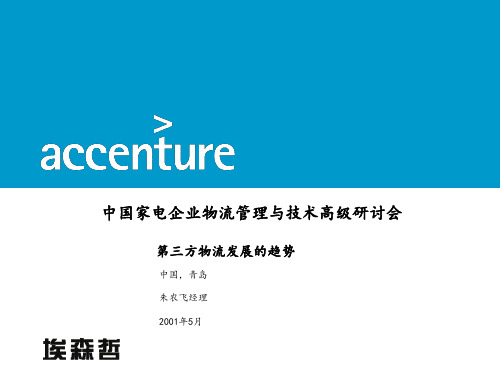
从全球的角度,没有一家第三方物流公司能够在多个地区成为多种行业 的物流提供商 以上客户的物流供应商
谁是世界的领先者?
地区 U.S.
Asia
汽车
电讯
公用事业
Ryder
Cellstar Ryder
Schneider Brightpoint
优化成本及优化服务
由于市场覆盖面的扩大和公司的国际化,第三方物流必须发现新的 方式扩大地域的覆盖面
传统的方法
跟随着顾客向国际化发展 与人联盟为顾客提供满意度 不断地建立国际化的能力 通过战略联盟来扩大自身能力 还有其他的能力提高竞争力?
全球化
新的方法
一些大型的 3PL 提供商在其自 身能力的发展和 新客户的发展 方面正在变得越来越主动
Value added activities (e.g. assembly, kitting)
Reverse logistics Track and trace
Import/export movement
Customs clearance status and data interfaces
合作伙伴和交易协议
理解客户的文化和环境是建立有效客户关系的关键
主要的业绩因素
关系的质量 灵活性 功能和战略的能力 流程和系统的可靠性 服务的连贯性 价值与收费 交付时间的可靠性 有效率/连续不断的信息化
主要的关系
积极的响应,以服务为导向 具有专业知识背景的团队
零售
Exel Menlo
食品 Exel
ACS MSAS UFreight
埃森哲 客户洞察方法
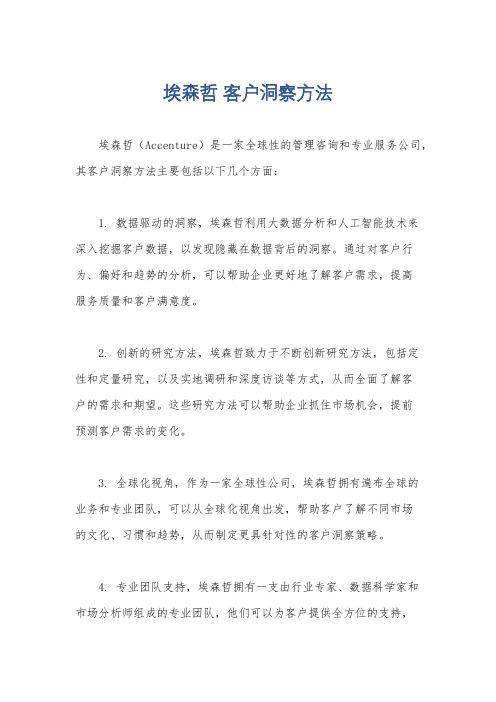
埃森哲客户洞察方法
埃森哲(Accenture)是一家全球性的管理咨询和专业服务公司,其客户洞察方法主要包括以下几个方面:
1. 数据驱动的洞察,埃森哲利用大数据分析和人工智能技术来
深入挖掘客户数据,以发现隐藏在数据背后的洞察。
通过对客户行为、偏好和趋势的分析,可以帮助企业更好地了解客户需求,提高
服务质量和客户满意度。
2. 创新的研究方法,埃森哲致力于不断创新研究方法,包括定
性和定量研究,以及实地调研和深度访谈等方式,从而全面了解客
户的需求和期望。
这些研究方法可以帮助企业抓住市场机会,提前
预测客户需求的变化。
3. 全球化视角,作为一家全球性公司,埃森哲拥有遍布全球的
业务和专业团队,可以从全球化视角出发,帮助客户了解不同市场
的文化、习惯和趋势,从而制定更具针对性的客户洞察策略。
4. 专业团队支持,埃森哲拥有一支由行业专家、数据科学家和
市场分析师组成的专业团队,他们可以为客户提供全方位的支持,
包括市场调研、数据分析、竞争情报等方面的服务,帮助客户深入
洞察市场和客户。
总的来说,埃森哲的客户洞察方法是基于数据驱动、创新研究、全球化视角和专业团队支持的,以帮助企业更好地了解客户需求,
抓住市场机会,提升竞争力。
埃森哲:2019年伦敦同业拆借利率调查报告

埃森哲:2019年伦敦同业拆借利率调查报告埃森哲(Accenture)的一份新报告显示,虽然大多数银行、保险公司和投资公司计划在2021年底逐步取消伦敦银行间同业拆借利率(LIBOR),但只有不到一半的受访者(47%)相信到完成过渡时他们才能拥有这样的能力。
LIBOR是全球主要银行相互借贷的平均利率,与大约400万亿美元的金融工具挂钩,包括信贷违约掉期、证券、学生贷款和抵押贷款。
埃森哲对全球127家金融服务机构和50家公司的调查发现,84%的机构已经制定了LIBOR过渡计划。
但是,4/10的受访者(41%)承认缺乏跨业务的统一方法;只有1/5的受访者(20%)认为已经为过渡做好了准备;只有少数机构(18%)将他们的LIBOR过渡计划描述为“成熟的”。
缺乏对支出优先顺序的详细规划以及整个企业的统一规划方法是阻碍过渡的主要原因。
例如,近1/4的受访者(23%)计划在未来三年内将资金分配给产品设计,只有17%的受访者计划将资金分配给运营和风险模型,这些领域在过渡期间可能会起到重要作用。
此外,报告还指出,金融服务组织内部的具体职能似乎没有为过渡做好充分准备。
只有15%的受访者表示他们的法律团队已准备好处理大量的合同补救和交易重组活动,只有14%的受访者相信自己的风险管理团队对过渡活动及其对风险管理的影响有详细的了解。
此外,企业还缺少跨地域的一致性。
近一半的受访者(47%)承认自己对理解不同司法管辖区的监管规定没有信心。
尽管监管机构敦促企业迅速摆脱LIBOR,但受访者认为2021年的最后期限可能是灵活的。
例如,1/4的受访者(23%)预测LIBOR将在2021年后逐渐停止,一半的受访者(51%)预计监管机构会在不确定性的情况下为他们的组织提供救济。
具有“成熟”过渡计划的机构看到了收入机会。
大多数受访企业都在采取谨慎的过渡方法,但具有“成熟”计划的公司可能更具有战略优势。
超过9/10的公司(94%)将LIBOR转型视为战略机遇;91%的公司认为转型产生的增量收入可以在未来三年抵消补救成本。
企业信用报告_新韩银行(中国)有限公司北京顺义支行

咨询公司埃森哲专业模板完整版

THANKS FOR WATCHING
感谢您的观看
客户满意度高
凭借优质的服务和良好的业绩,埃森哲赢得 了众多客户的信任和好评。
CHAPTER 06
服务流程
需求分析
01
明确客户目标
深入了解客户的业务需求和目标 ,确保咨询项目能够满足客户的 期望。
收集信息
02
03
分析问题
通过访谈、问卷调查等方式收集 客户业务相关的信息,为后续分 析提供数据支持。
基于收集的信息,识别客户业务 中存在的问题和挑战,为制定解 决方案提供依据。
根据分析结果,埃森哲为 企业设计符合其发展需求 的人力资源管理体系,包 括招聘、培训、绩效管理 等方面。
埃森哲为企业提供人力资 源培训服务,提高企业人 力资源管理的专业水平。
在项目实施过程中,埃森 哲对项目进行持续的监控 和评估,确保项目达到预 期的效果。
案例三:企业战略咨询
企业战略是企业发展的核心
总结与反馈
在项目结束后进行总结,提炼经 验教训,为客户提供持续的支持 和改进建议。
方法论工具
行业研究工具
利用专业的行业研究工具,收集最新的市场数据 和趋势,为解决方案提供有力支持。
项目管理工具
采用高效的项目管理工具,确保项目进度和质量 的控制,提高工作效率。
ABCD
数据分析工具
运用先进的数据分析工具,对收集到的数据进行 深入挖掘,揭示数据的内在联系和规律。
培训与认证
团队成员定期参加各类培训和认证,以确保其专 业知识和技能的更新与提升。
团队优势
行业洞察力
团队成员对各行业发展趋势有深入了解,能 够为客户提供前瞻性的战略建议。
项目管理能力
团队在项目管理方面具有丰富的经验,能够 确保咨询项目的顺利实施。
某韩国银行咨询报告(英文版).pptx

Navigator
Operations Processing
Customer Maintenance - Details - Relation-
ship - Credit
history
Reg-ulatory infor. MAauinthteonriatnyce - Ratios Reporting
1
ISP Project Executive Summary - February 15, 1995
Information Action Plan Overview
1. Information Action Plan Overview
2
ISP Project Executive Summary - February 15, 1995
- D.M
- Consulting
Needs Analysis
- Customer - Products - Market
Campaign - PPlalannning
Developmen t - Sales
Promotion Plan
Branch Opening
- GIS
Service Customer Management - Attribute - Exposure /Limits Relationshi p
- EFT/POS - SWIFT
BOK Wire
- Borrowing - National
Treasury
Sales & Marketing
Relationship Management
Customer Mgmt.
Credit Control
Sales Support - Cust. Seg. & Selection
埃森哲需求分析
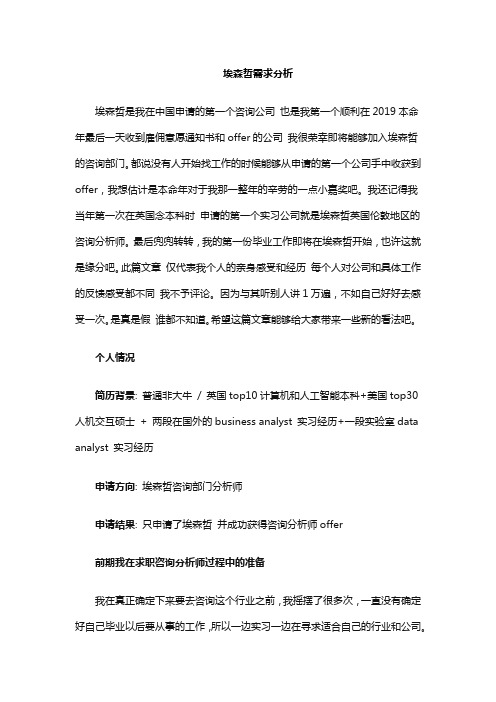
埃森哲需求分析埃森哲是我在中国申请的第一个咨询公司也是我第一个顺利在2019本命年最后一天收到雇佣意愿通知书和offer的公司我很荣幸即将能够加入埃森哲的咨询部门。
都说没有人开始找工作的时候能够从申请的第一个公司手中收获到offer,我想估计是本命年对于我那一整年的辛劳的一点小嘉奖吧。
我还记得我当年第一次在英国念本科时申请的第一个实习公司就是埃森哲英国伦敦地区的咨询分析师。
最后兜兜转转,我的第一份毕业工作即将在埃森哲开始,也许这就是缘分吧。
此篇文章仅代表我个人的亲身感受和经历每个人对公司和具体工作的反馈感受都不同我不予评论。
因为与其听别人讲1万遍,不如自己好好去感受一次。
是真是假谁都不知道。
希望这篇文章能够给大家带来一些新的看法吧。
个人情况简历背景: 普通非大牛/ 英国top10计算机和人工智能本科+美国top30人机交互硕士+ 两段在国外的business analyst 实习经历+一段实验室data analyst 实习经历申请方向: 埃森哲咨询部门分析师申请结果: 只申请了埃森哲并成功获得咨询分析师offer前期我在求职咨询分析师过程中的准备我在真正确定下来要去咨询这个行业之前,我摇摆了很多次,一直没有确定好自己毕业以后要从事的工作,所以一边实习一边在寻求适合自己的行业和公司。
本科毕业以后,代码能力荒废+对于程序员工作不感冒却极其佩服那些有逻辑的技术人,我大概将自己的道路定位在客户需求分析+技术支持这一块。
然后从我在纽约开始作为business analyst实习的时候我就一边和自己的manager聊天来寻求自己的特质适合什么方向的工作。
以及不断征询身边人的建议,最终抱着自己在实习结束时还有对于商业BA和客户咨询分析的兴趣,将自己的求职目标主要放在了咨询行业的咨询分析师或者第二选择为互联网行业的business analyst 以及第三选择data analyst。
在确定了以后,我试图找准自己的定位,不论国内还是国外的咨询公司,第一梯队都是MBB,而且招收的目标学校均为顶尖商学院毕业生,再加上我决定申请咨询行业的时候已经错过美国秋招的黄金阶段于是我着重把自己的目标放在了第二梯队的咨询公司。
埃森哲-APPARC韩国银行咨询报告

Application ArchitectureDecember 7, 19955.3A PPLICATION A RCHITECTURE (3)5.3.1 Section Overview (5)5.3.2 Application Architecture Model (6)5.3.3 Current Application Architecture (10)5.3.4 Application Architecture Guidelines (15)5.3.5 Proposed Application Architecture Strategy (16)5.3 Application ArchitectureThis section describes Bank X’s current and future application architectures--the systems and applications used by customers, branch personnel, business users, executives, and external agency to support Bank X’s business environment. The application architecture is built based on use r requirements, new technical solutions, and banking best practices. Where possible, we have identified potential technical an d business supported changes that could help Bank X’s systems. The Application and Data plan describes the actual planned improvements or new applications to be built over the next five years.Key featuresThe focus of the new application architecture is to enhance market-driven processes--processes that improve Bank X’s position in the Korean banking environment by providing better customer service, products, increased market coverage, and competitive prices. Many of the new applications focus on improving management information to help Bank X manage a larger bank and to more precisely evaluate customer needs. Highlights of the new application architecture include: •New sales and marketing systems⇒Needs analysis (customer, product, and market)⇒Campaign planning (new channels, sales, promotion activities)⇒Branch opening support (global information system)⇒Sales support (sales schedule, customer consulting activities)•Enhanced customer management systems⇒Corporate data information management (financial, personnel, news)⇒Retail customer information management (name, address, family relationships)•Advanced credit systems⇒Corporate credit analysis⇒Customer credit scoring•New management information systems⇒Business unit profitability (customer, product, branch)⇒Regulatory and Compliance⇒Treasury management⇒Market risk⇒Product managementPotential risksTo achieve the application architecture, Bank X will need to carefully coordinate technical infrastructure improvement, database development, and EDP resources. This requires managing the following risks:•Customer applications (e.g., ATM, credit card, phone banking, electronic banking) are not competitive with other Korean banks or non-Korean banks (e.g., Citibank)•Changing customer preferences may require changed application focus, new products, or new services•Bank X EDP department lack the resources to both support existing applications and build new technical infrastructure•Bank X tries to build to many new applications•Existing applications are do not meet future needs or can not integrate well with new applications•Technical infrastructure and databases can not support new applicationsBenefits of Application ArchitectureAs application architecture is a high level model shared by both business and EDP personnel to identify the types of systems Bank X requires. It is a tool similar to a building architecture that provides a model to be used to plan projects, design new systems and databases, and prioritize EDP activities.•Business and Technology department cooperation The application architecture should be shared document between business units and technology areas. Business units, operations personnel, branch personnel, and executives should be able to identify the applications that support their areas. Changes to those applications should be clearly distinguished as should new applications•Increased Usability The architecture should provide users with the applications they need to support their tasks and to meet their type of work.•Flexibility and Isolation By separating applications based on business functions, the application should be allowed to grow in sophistication with the business.Secondly a change to one business areas applications should not impact other business areas.•Identification of Packaged Solutions The application architecture and the application plans should describe applications to a detailed enough to identify whether packaged solutions can meet business requirements.•Standardization The architecture should identify opportunities to share program components and data across applications. It should also help indicate the proper platforms for applications.5.3.1 Section OverviewThe application architecture section is comprised of the following sections:5.3.2 Application Architecture Model - presents a conceptual model used to categorize and visualize the architecture components.5.3.3 Architectural Transformation - Describes the process of building Bank X’s new application architecture5.3.4 Application Architecture Guidelines - presents guidelines that should be followed in order to implement a successful architecture.5.3.5 Proposed Technical Architecture Strategy - this section illustrates the likely features of the new architecture. It contains the following sub-sections:- 5.3.5.1 Service Delivery- 5.3.5.2 Central Processing- 5.3.5.3 Relationship Management- 5.3.5.4 Management and Control- 5.3.5.5 Information Delivery5.3.2 Application Architecture ModelThe goal of the architecture strategy is to define an application architecture that will support Bank X's future business requirements. To assist in the development process, Andersen Consulting's Vision Application Architecture Model was chosen as a design tool. This section shows how the proposed application architecture was designed using the Vision Application Architecture Model as a starting point. The components of the Vision Application architecture are:1.Service Delivery2.Central Processing3.Relationship Management4.Management and Controlrmation Delivery6.Gateways.1. Service DeliveryService Delivery supports all banking functions provided to benefit Bank X’s customers. These include the branch network, internal department s, customers, correspondent banks and clearing and funds transfer service providers. They may use a variety of techniques to access the organization's information, such as terminals in branches, executive workstations, telemarketing workstations, ATMs, home and telephone banking and corporate workstations.The objective for Service Delivery is to provide an integrated and seamless interface to all users. Traditionally, screens and menus were developed as part of a specific system such as branch sales, credit scoring or account processing. However, to reduce costs and improve customer service organizations are trying to streamline their business processes. For instance, they might want not only to sell a loan to a customer, but also get credit authorization and set up an account on the spot.The range of functions provided by the system must match the range of activities the user performs. If front office staff in a branch are supposed to provide customer service and to sell, then they need a platform which will allow them to do both, irrespective of whether they are accessing a product processing system or a sales support system.2. Central ProcessingCentral processing includes the transaction processing traditionally supported by central systems. This processing ensures t hat the bank’s transactions are properly executed and that the bank’s various accounts are properl y managed. Central processing consists of four components:Operations ProcessingIn order to process transactions a number of common functions need to be performed before they are applied to a particular system. The user's authority to carry out the transaction needs to be authenticated - for instance, ATM PIN validation. The source and nature of the transaction need to be recorded for use in activity measurement and for productivity monitoring. Security requires that transactions are properly audited and in some instances business rules dictate thata second person must authorize the transaction. Journal entries must be generated. If transactions are not applied to the underlying product processing system,these exceptions must be captured and reprocessed efficiently.Closing and SettlementClosing and settlement functions ensure that all accounts are properly updated, reconciled, and accurate. It requires transferring information between various entities including other banks, clearing agencies, and across branches. The system should process business transactions rather than a series of more physical transactions dictated by the limitations of product administration systems. For instance, transferring money from one account to another is a single business transaction. This remains true even when the accounts are in different currencies, processed on different systems, and require several journal entries.Product AdministrationProduct administration functions perform all product specific processing for deposits, loans, foreign exchange, credit cards, bill payment, trade finance, and other types of products.Product FactoryA product factory is a system that supports common product functions such as interest calculation and payment, pricing, product reporting, product accounting,and other product calculations. Many banking institutions are using object-oriented techniques to manage their many product types.3. Relationship ManagementRelationship Management supports sales and marketing, customer management and credit control. These are business functions which relate principally to customers and households as opposed to individual accounts. Marketing campaigns are managed across the various distribution channels available. Then, by drawing on information about individual customers, other members of their households, their products, product usage patterns, demographics and behavioral psychographics, needs are identified. Campaign execution can be in the form of direct mail, telemarketing or the passing of leads to branches. Sales support provides facilities for demonstrating product benefits to customers, managing leads in progress and closing the sale.Customer service histories are maintained recording the quality of the individual relationship. For business customers and high net worth individuals, information on customer profitability and the relationship as a whole may be used to determine how to structure and price product offerings. Institutions also need to report on the individual customer relationship for regulatory purposes such as to the Bank of Korea.Credit management includes not only the initial scoring of applications but the subsequent monitoring and resetting of limits. By understanding a customer's complete relationship different decisions can be made. For instance, a customer with an unauthorized overdraft on a checking account but a large balance on deposit should be treated differently from a customer with a similar unauthorized overdraft who has also exceeded the limit on his credit card. Part of the process is likely to involve credit scoring and using third party information for credit decisions.4. Management and ControlThe Management and Control component of our architecture is divided between management information functions and administrative functions. Administrative functions, which are generally not specific to the financial services industry, form the basis of effective organization and office management.The Management Information component supports the activities of planning, analysis, monitoring and reporting. It is divided into three broad categories: •Financial: Information on costs, profits and positions for use in producing financial position and regulatory reports (including BIS reports), budgeting and forecasting, and assessing risk.•Operations: Information on productivity and service quality.•Sales: Information on current sales performance and that required to assess the actual profit and potential for profit from different products and sectors of the market.Executive information is provided from all three categories in a more summarized form.5. Information DeliveryInformation Delivery manages the external delivery of information whether on paper or by electronic means. Information Delivery may involve additional processing such as that required for Electronic Data Interchange (EDI). It allows financial institutions to be a service provider for information exchange between clients and third parties. Indeed the financial institution may choose to position itself as the provider of the value-added EDI network itself.The physical printing of reports, statements and mailings are also Information Delivery activities. It can often be more cost effective to subcontract some of these activities to third parties. Through Information Delivery it is also possible to consolidate orders for physical media such as checkbooks and plastic cards, realizing greater bulk discounts.6. GatewaysThe gateways are the components generally systems software or middleware that enable information to be distributed between applications as well as shield the applications from changes in the underlying technical or data architectures. The four main gateways are:•Driver: Manages the process of getting valid business transactions to the appropriate application, including translating single business transactions into one or many systems transactions. For example, when a central customer master file is updated, the driver process will ensure that this transaction is passed to the relevant applications.••Integrator: These processes will be responsible for integrating information from the various applications. An example would be the summarization of data from the customer or product information to evaluate branch profitability.•Navigator: Establishes and maintains the bank’s view of its relationships and systems. It maintains information about clients, interm ediaries, other third parties and their interrelationships.•Distributor: These processes consolidate information for use both within Bank X and also for external organizations such as clearing and settlement organizations or for SWIFT.Gateway functionality is further discussed in the technology plan.5.3.3 Architectural TransformationTransforming from a centralized mainframe architecture to a new distributed architecture is a difficult task, and one that many organizations have failed in. Nevertheless the realities of today’s banking and technology environments have made architectural transformation a necessity. More and more the banks with best technologies and information systems have a competitive edge. Banks with advanced technology can:•Deliver advanced services to customers•Spot market trends quicker•Bring products quickly to market that truly meet customer needs•Capture new market segments•Discriminate between profitable and unprofitable customers•Discriminate between high risk and low risk products and customers•Mitigate their risks through diversification or hedgingTo develop Bank X’s new application architecture we have taken the following steps which we hope will lead to successful arch itectural transformation.Step 1 - Recognize the changing environmentBefore the project started Bank X had recognized that both technology and Korean banking were evolving at increasingly rapid rates. It is no longer possible to plan technology on a one year basis, nor can one use the technology developed for banks 10 years ago. In the first step, we reviewed the current Transaction System - Reporting system architecture which is based on IBM Japan’s model for banks 10-15 years ago.With the changing technology, this model has become outdated and for the most part, Japanese banks are searching for new methods. Unfortunately for the larger banks, changing is difficult after 15 years of investment in mainframe systems. Sometimes being the largest bank in the world can be a liability.Step 2 - Identify new methods for grouping applicationsThe second step was to find ne w methods of grouping Bank X’s applications (rather than simply grouping by on-line or reporting). Our method was to choose six data and processing characteristics (see section 5.1) and classify the applications by these characteristics.Step 3 - Regroup system supported functions into new applicationsIn step 3, we regrouped the business functions based primarily on the user type, processing type, and data summarization level. This lead to a preliminary application architectureStep 4 - Validate against other application architecturesStep 4 was the process of validating Bank X’s architecture against Andersen Consulting Vision architecture (described in Section 5.3.2) as well as against other bank’s architectures. This validation lead to a few adjustments. This architecture is shown in figure 5.4.Figure 5.3.3.2 - Current ApplicationsStep 5 - Map in new business requirementsThe fifth step was to map in new business requirements by identify potential applications based on the user requirements developed by the management assessment team.Step 6- Revalidate against the vision architectureThe final step was to revalidate the future architecture against the Vision application architecture. This lead to the final architecture picture.It should be noted that the final architecture should represent Bank X’s requirements. A simple implementation of the Vision architecture, IBM’s architecture, or any other architecture would in the end fail as these architecture are generic based on many banks.5.3.4 Application Architecture GuidelinesThis section presents guidelines that will be followed throughout the implementation of the application architecture. These guidelines will be used as a starting point for Bank X in their decision making process. Each guideline will be assigned a relative importance which will be used in the selection of architecture components. They are based on Andersen Consulting's experience in implementing similar architectures in the retail financial services industries.The guidelines are as follows:Architecture driven by the business The selecting and building of architectural components should be driven by the needs of the business and not by technology. Bank X’s EDP department must understand the business requirements and the business lines must understand new applications such as risk management, smart cards, and virtual banking.Unify Applications Users should be supported by a small number of applications in such a way that each business functions require only a single application to operate.User Driven The user interface, application logic, information availability should be based on the users requirements. Knowledge workers (product specialists, business managers, loan officers) require advanced functions and reporting. Executives require summarized information from theentire bank. Tellers and operations clerks require easy to operate systems that allow them to process transactions quickly. Customer systemsshould have quick response times and attractive user interfaces.Consistent, Easy to Use In all cases, the user interface should be intuitive . Application screens and windows should follow interface standards so that different applications have the same “look and feel”. On-line help screens should be available for all functions.Flexible The architecture should be able to support the introduction of new products and changes in functionality that are inherent in Bank X's business. The architecture should also be able to utilize the latest developments from third party vendors to support new products and allowproductive custom development and enhancements.Well documented All applications should be clearly documented so that application developers, maintainers, and users can clearly understand the relevant functional and technical components.Package Driven Where practical, the application architecture should use commercial software packages rather than be custom developed. Packages are less expensive than building software at Bank X and can provide full functionality quicklyIntegrated Information should be shared across applications. Where possible the same databases should be used across applications. Applications should share software components where possible including validation routines, product calculations, data access routines, logging, and othercommon functions.Phased Approach for Software Roll out A phased approach should be used for the software roll out. Implementing all applications at one time would likely result in a number of partially or unfinished projects.Secure To protect the confidentiality of the bank’s customers and to secure the funds deposited at Bank X, the architecture must pro vide robust security at the network, system, application, data. While ensuring that no unauthorized access is possible, the security must not inhibitefficient use of the system by authorized users.5.3.5 Proposed Application Architecture StrategyThis section 5.3.5 outlines the proposed application architecture strategy to support Bank X's business requirements. This architecture is based on the user requirements identified in section 5.1. This section proposes a application architecture that will better enable Bank X’s growth and pro fitability goals. The new architecture focuses on developing systems to evaluate product and customer needs, costs, profitability, and requirements. Detailed application strategies are described in appendix 1.5.3.5.1 Service DeliveryThe service delivery approach is shown in figure 5.3.5.1 The major strategies in the service delivery are as follows:Customer SystemsCustomer systems will become increasingly important in the Korean Banking environment over the next five years. Competition from non-Korean banks such as Citibank using advanced technologies, electronic payment, Internet access will raise the technology and application stakes.ATM/CDAt present, there are no plans to upgrade the ATM and CD network with the exception of building ATMs in the new branches. This decision is based on the strategic focus on Middle/Upper income customers who prefer face to face contact.This strategy is contrary to the trends seen in the US, Japan, and Europe where banks have significantly upgraded their ATMs. Already Citibank hasimplemented advanced 24-hr ATMs in Korea that provide a wide range of functions. As we have seen in the US, Europe, and Japan, customer systems can be a key differentiator for the future. In the US, for example, most people choose their bank based on the proximity of the ATMs to their work or home (rather than branch proximity). Similarly, most customers in the US ever enter the branch. Banks in Switzerland provide full function ATMs that let customers perform FX transactions, buy/sell stock, review interest rates, and other advanced banking functions.Many Western banks are considering adding multimedia features(sound, graphics, and video) to their ATMs which requires both hardware and software upgrades. Nationwide bank in England has built virtual branches that provide the bank’s customers with a graphic image of a bank.In the application plan Bank X must decide whether they believe these trends will occur in Korea and decide how to react.Electronic Banking (Home/Firm)At present there are few plans to upgrade Electronic banking, this text-based system was built recently and is similar to other Home/Firm banking applications in Korea. One strategy that Bank X is exploring is the use of the Internet Web server to distribute information about Bank X to current and potentialcustomers.In the US, Citibank also has an easy to use electronic banking software package which it distributes for free. The other new trend is to use the Internet Web to make payments and provide banking services. Bank of America is piloting Internet based banking in the US.Credit CardAt present there are few plans to upgrade the Credit Card functions, The main functions currently supported are cash retrieval and payment functions.In the US, credit cards have become a major force in banking. Most large purchases, entertainment, and travel expenses are paid by credit card. In addition, credit cards are used for mail order purchases. While credit cards are not as popular in Japan and Europe, usage is increasing. The major trend in the US is to offer credit cards with affinity relationships with Airlines, Hotels, and other leisure companies. This cross-marketing has enabled smaller or regional banks to become major credit card providers. The goal is to find customers who hold balances on their cards, but tend to pay off the loans eventually.A new type of credit card is gaining popularity in France: the smart/integrated circuit card, which stores account and transaction information on the card. Thisis the first phase of electronic cash.Phone BankingTelephone banking will be upgraded to provide full automated (touch-tone) service that will enable customers to check balances and transfer money by phone.This service will replace the use of human operators and will make phone banking available for 24hrs.Branch SystemsBranch systems refer to the systems used by female tellers, branch clerks, and branch male associates to perform banking functions such as deposit taking, bill payment, lending, foreign exchange, and account management. Systems for tellers and branch clerks will remain stable for the next few years. The major change is to replace the old teller terminals with PCs which has already occurred in the majority of the branches. Banks in the US are limiting their spending on bank teller systems as fewer transactions are through the old teller system and more through ATMs.Lending systems will be upgraded to improve credit checking and better identify customers who have failed to make loan payments. Barclays Bank in London has a system that automatically performs credit scoring of customers (i.e., evaluates their credit risk and enables tellers to make small loans in 10 minutes)External ProcessingExternal processing supports functions which are used to communicate with external agencies such as the Bank of Korea, other banks, and credit card companies. These applications are updated as necessary to meet the needs of the external companies.Transaction ProcessingTransaction processing systems support bill and check clearing functions including GIRO.Information FeedsInformation feeds systems support interaction with external clearing and credit card agencies. This includes wire transfer (SWIFT) and credit card payment Point of Sale (POS) , and electronic funds transfer (EFT).BOK WireBOK Wire from the BOK are used to make government sponsored loans to entrepreneurs and middle-sized companies. It also supports taking deposits from the BOK.5.3.5.2 Central ProcessingCentral processing supports bank operations--deposits, lending, account closing, clearing and settlement, product management, and product processing. The majority of these applications were built in the first five years. Because these systems originated in a different banking environment (before interest rate changes, complex products, deregulation), they must be constantly maintained and upgraded. Over the next five years, most effort will be to standardize and document these applications. Secondly these application’s databases will be made more uniform to enable transfer to the enter prise data server.Where possible, shared processing such as validation, logging, journal processing, authorization handling, work measurement, financial audit trailing, transaction handling should be identified and separated into common modules.5.3.5.3 Relationship ManagementRelationship management application support three key areas: sales and marketing, customer management, and credit control. All three of these areas will have significant new applications over the next five years.Sales and MarketingSales and marketing systems are used to enable further growth in Bank X’s revenues. Their focus includes:•opening of new branches•attracting new customers to Bank X•selling more products to current customersSales SupportSales support functions include customer segmentation and selection, direct marketing, and consulting services. These applications rely on a strong customer database and good query tools to provide information to sales personnel in the branches. A key new focus area in sales support is the delivery of advisory services to customers (e.g., investment , retirement, and tax planning). These applications should also enable sales professionals to manage leads and sales visits.Needs AnalysisA Needs analysis application will be built to enable sales and marketing professionals to identify potential new products, customer segments, and marketsegments that could produce increased revenues and profits for Bank X. These systems will enable Bank X’s marketing teams to analyze their currentcustomer preferences for products and help them identify new types of loans, savings accounts, etc. These systems also require good customer and product databases as well as statistical analysis tools.。
艾森哲对全球个国家电子政务的调研报告

艾森哲对全球24个国家电子政务的调研报告前言大约5年前,许多国家和地区的政府便开始制定提供在线服务的规划方案,此后,在实施这些方案的过程中,他们都取得了不同程度的进展。
在线服务的优点是显而易见的,它提供的服务更快更省更容易实现个性化,而且效率更高,国民和企业能够每周7天,每天24小时使用这些服务。
然而实践证明,要想把电子政务的优势变成现实,并不是一件容易的事情。
在推动电子政务的过程中,会遇到一系列复杂的问题,比如法律、管理、规章、社会和政治等种种因素,形成了一些复杂的制约条件,这是向电子政务过渡的过程中必须解决的问题。
近年来,埃森哲公司每年都进行一次涉及有关政府的全球性电子政务调研工作,以确定他们各自电子政务的发展状况。
在我们的最新调研报告《电子政务领导—将规划变为现实》中,我们发现,尽管发展速度比较慢,但是各个政府正在努力实现他们的电子政务规划目标。
更为重要的是,他们日益认识到,电子政务不仅要解决相应的技术问题,而且要使这项技术成为改革政府运作方式的工具之一。
他们开始认识到,这种改革并不只是将各种服务移到网上,而是必须重新设计组织架构和工作流程,把国民放在电子政务的中心位置,将各个机构的在线服务集成起来,以简化交互程序,降低成本,改进服务。
只有建立起合理的管理架构,并且与推动整个政府改革的政治意志相结合,政府服务的改革才能实现。
在这份调研报告中,我们概要地介绍了中国政府的电子政务运作情况,并且与我们在2002年调研的另外23个政府的情况进行了比较。
不过应该指出,对这23个国家和地区政府进行的调研是在2002年1月进行的,而在过去的几个月中,他们的电子政务水平的排序很可能已经发生了变化。
根据去年的研究,我们发现这些政府可能在较短的时间内电子政务方面取得相当大的进展。
因此,对中国与其他政府之间进行的比较并不是绝对的,只是用来说明他们电子政务运作的相对情况。
我们把中国调研结果与其他政府进行了比较,并用对中国在电子政务方面取得的经验亦与其他政府进行了比较。
exeutive summary范文
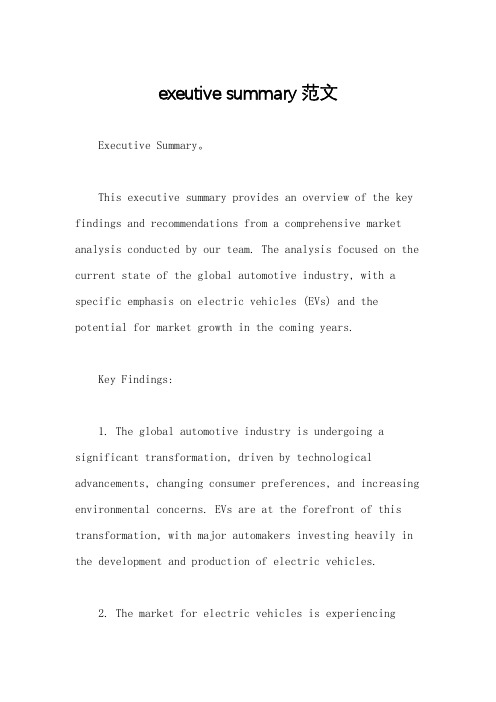
exeutive summary范文Executive Summary。
This executive summary provides an overview of the key findings and recommendations from a comprehensive market analysis conducted by our team. The analysis focused on the current state of the global automotive industry, with a specific emphasis on electric vehicles (EVs) and the potential for market growth in the coming years.Key Findings:1. The global automotive industry is undergoing a significant transformation, driven by technological advancements, changing consumer preferences, and increasing environmental concerns. EVs are at the forefront of this transformation, with major automakers investing heavily in the development and production of electric vehicles.2. The market for electric vehicles is experiencingrapid growth, with sales increasing by double-digit percentages each year. This growth is being driven by government incentives, improved infrastructure for EV charging, and a growing awareness of the environmental benefits of electric vehicles.3. China is leading the way in the adoption of electric vehicles, with the government implementing aggressive policies to promote the use of EVs and reduce air pollution. As a result, China has become the largest market forelectric vehicles, with domestic automakers such as BYD and NIO gaining significant market share.4. Despite the growth of the EV market, there are still significant barriers to widespread adoption, including concerns about range anxiety, the high cost of EVs, and a lack of charging infrastructure in many regions.Recommendations:1. Automakers should continue to invest in the development of electric vehicles, with a focus on improvingbattery technology, reducing the cost of EVs, and increasing the range of electric vehicles to alleviate consumer concerns about range anxiety.2. Governments should implement policies to incentivize the adoption of electric vehicles, including tax credits, rebates, and subsidies for EV purchasers, as well as investments in charging infrastructure to support the widespread adoption of electric vehicles.3. Companies should explore opportunities to enter the electric vehicle market, either through partnerships with existing automakers or through the development of new technologies and solutions to support the growth of the EV market.4. The automotive industry should continue to collaborate with stakeholders in the energy sector to develop innovative solutions for charging infrastructure, including fast-charging technologies and the integration of renewable energy sources to power electric vehicles.Conclusion:The global automotive industry is at a critical juncture, with the transition to electric vehicles presenting both challenges and opportunities for automakers, governments, and other stakeholders. By addressing the barriers to adoption and investing in the development of new technologies, the industry can capitalize on thegrowing demand for electric vehicles and drive sustainable growth in the years to come.。
埃森哲报告
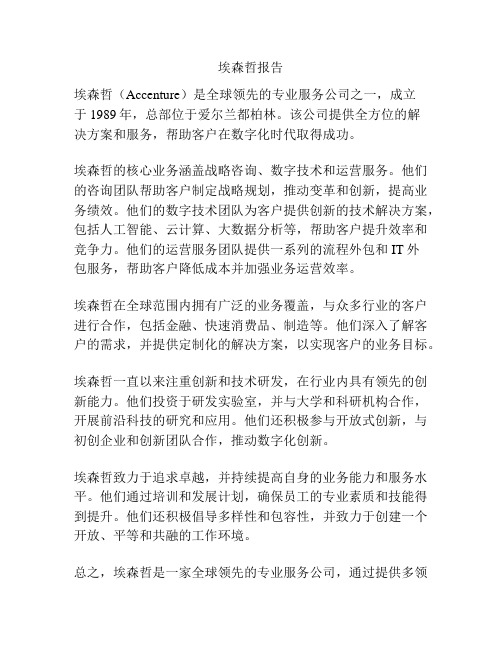
埃森哲报告
埃森哲(Accenture)是全球领先的专业服务公司之一,成立
于1989年,总部位于爱尔兰都柏林。
该公司提供全方位的解
决方案和服务,帮助客户在数字化时代取得成功。
埃森哲的核心业务涵盖战略咨询、数字技术和运营服务。
他们的咨询团队帮助客户制定战略规划,推动变革和创新,提高业务绩效。
他们的数字技术团队为客户提供创新的技术解决方案,包括人工智能、云计算、大数据分析等,帮助客户提升效率和竞争力。
他们的运营服务团队提供一系列的流程外包和IT外
包服务,帮助客户降低成本并加强业务运营效率。
埃森哲在全球范围内拥有广泛的业务覆盖,与众多行业的客户进行合作,包括金融、快速消费品、制造等。
他们深入了解客户的需求,并提供定制化的解决方案,以实现客户的业务目标。
埃森哲一直以来注重创新和技术研发,在行业内具有领先的创新能力。
他们投资于研发实验室,并与大学和科研机构合作,开展前沿科技的研究和应用。
他们还积极参与开放式创新,与初创企业和创新团队合作,推动数字化创新。
埃森哲致力于追求卓越,并持续提高自身的业务能力和服务水平。
他们通过培训和发展计划,确保员工的专业素质和技能得到提升。
他们还积极倡导多样性和包容性,并致力于创建一个开放、平等和共融的工作环境。
总之,埃森哲是一家全球领先的专业服务公司,通过提供多领
域的解决方案和服务,帮助客户在数字化时代取得成功。
他们以创新为驱动力,致力于提供高质量的服务,并不断提升自身的能力和业务水平。
某韩国银行咨询报告

某韩国银行咨询报告咨询报告:韩国银行业的现状与发展趋势一、引言韩国作为亚洲四小龙之一,其金融业一直以来都发挥着重要的作用,尤其是韩国的银行业在国家经济发展中扮演着重要的角色。
本报告旨在对韩国银行行业的现状与发展趋势进行分析,并提供相关建议和咨询。
二、韩国银行业的现状1. 市场规模截至目前,韩国共有大约30家商业银行,其中包括国有银行、外资银行和韩国银行的子公司。
这些银行的总资产规模约为2000万亿韩元,其中韩国银行的资产规模占比最大。
2. 市场竞争格局韩国银行业存在着激烈的竞争,竞争主要集中在三个方面:客户、产品和服务。
各家银行纷纷加大投入力度,通过推出个性化的金融产品和提供更高质量的服务来吸引客户。
3. 数字化转型韩国银行业正积极进行数字化转型,加强与科技公司的合作,引入人工智能、大数据分析等技术,提高银行的效率、便利性和安全性。
同时,网上银行和移动银行已经成为主流,银行业务渠道的多样化极大地方便了客户。
三、韩国银行业的发展趋势1. 大力发展跨境业务韩国银行业正越来越关注国际化发展,积极开展跨境业务,特别是与东南亚和中国等国家和地区的金融合作。
这将有助于韩国银行扩大其业务范围和市场份额。
2. 注重金融科技创新随着科技的快速发展,金融科技在银行业的应用越来越广泛。
韩国银行业已经意识到金融科技对于提升金融服务水平的重要性,并将其作为重要战略进行推动。
未来,金融科技将在自动化、智能化、风控等领域发挥更加重要的作用。
3. 推动可持续发展在气候变化和环境问题日益引起关注的背景下,韩国银行业也开始关注可持续发展。
通过推动绿色金融、绿色信贷和社会责任投资等措施,韩国银行业正积极参与到可持续发展的进程中。
四、建议与咨询1. 加强创新能力韩国银行业需要不断提升创新能力,积极引进新兴技术,探索金融科技在银行业的应用。
此外,银行还应该加强与科技公司的合作,通过共享资源和开展联合研发,提高技术水平,以满足客户的多样化需求。
- 1、下载文档前请自行甄别文档内容的完整性,平台不提供额外的编辑、内容补充、找答案等附加服务。
- 2、"仅部分预览"的文档,不可在线预览部分如存在完整性等问题,可反馈申请退款(可完整预览的文档不适用该条件!)。
- 3、如文档侵犯您的权益,请联系客服反馈,我们会尽快为您处理(人工客服工作时间:9:00-18:30)。
Needs Analysis
- Customer - Products - Market
Campaign - PPlalannning
Developmen t - Sales Promotion Plan
Branch Opening
- GIS
Service Customer Management - Attribute - Exposure /Limits Relationshi p
Technology Plan
Information Action Plan Overview
Phase 1
Phase 2 Phase 3
Service Delivery
Customer
ATM/CD
- DW
- UP - AC Transfer
Phone
Banking - TR Service - Account
1
ISP Project Executive Summary - February 15, 1995
Information Action Plan Overview
1. Information Action Plan Overview
2
ISP Project Executive Summary - February 15, 1995
Current Situation Assessment
IT Strategy
Data & Application
Plan
Information Action Plan
IT Possibility Analysis
3
ISP Project Executive Summary - February 15, 1995
Customer Profitability - Customer
Relationship
Third Party Reporting of Cust. Details
- KBF, BOK - Checking
real name
- ScCorreidnigt M- aCnraegdeitment Ref. - Limit
Navigator
Operations Processing
Customer Maintenance - Details - Relation-
ship - Credit
history
ReMg-Auaulaitnthotoernryiatiynnfcoer. - Ratios Reporting
Schedules
EX/RM - Others IQ
Male Processing
- Loan, Mortgage - Card, Borrowing
- Trade FI - Others IQ
External Processing
Transaction
Information
Processing
Feeds
- Clears from other banks
Information Action Plan Summary Report
1) Information Action Plan Overview 2) The Future: The Case for Change 3) Strategic Application Projects 4) Technology Infrastructure & EDP Organization 5) Programme cost, resources, and manpower 6) Programme & Change Management 7) Next Steps
IQ
.etc
Credit Card
- Cash Service
Home/Firm - TR Service
- Account IQ - Internet
- Virtual
Bank
Teller/Male
Female - OPproenc(eACs,sing
Cust) - DP(TR money
other banks) - Foreign
Information Action Plan Overview
The Information System Planning (ISP) project is complete. We have identified a 5 year
application strategy (shown on next page) aligned with Bank X
Stage 1
Stage 2
Business & Competition Assessment
Organization Plan
Application, Data, and Technical Strategies
Projects and Schedules
Scope Definition & Classifications
Setting &
Monitorin g
Debt -CDoelbletcotrion list - Legal Notice - Recovery Tracking
Driver
Transaction Management - Financial - Non-
financial
Workflow Management
' s business strategy. We
have also identified the data and technology infrastructures, projects, and schedule to
carry out these strategies.
- ISP Planning Project Workplan -
GIS
- Geographic Demographic - Branch attribute
- GIRO
- EFT/POS - SWIFT
BOK Wire
- Borrowing - National
Treasury
Sales & Marketing
Relationship Management Cu Control
Sales Support - Cust. Seg. & Selection - D.M
